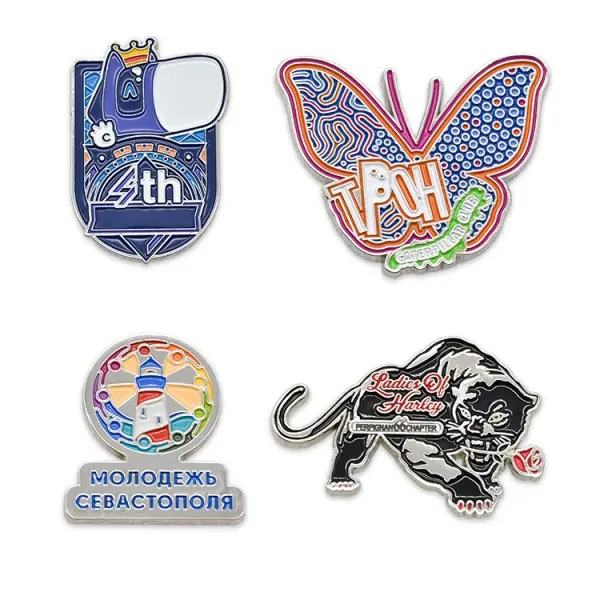The high-temperature curing after baking varnish filling is a key process that endows the color fastness and gloss of the badge. It is necessary to ensure the curing effect through details such as temperature curve control, equipment parameter setting, and workpiece placement norms. The following are the specific operation procedures, technical key points and solutions to common problems:
I. Preparations before curing: Ensure that the workpiece condition meets the standards
Re-inspection of filling quality
Check the colored surface by the strong light side illumination method: If there are bubbles, depressions or pigment accumulation, they need to be repaired before curing (refer to the “bubble treatment” method in the previous text) to avoid the expansion of defects at high temperatures.
Example: If there is a missing color in the 0.5mm wide line, the pigment should be filled with a needle tube and left to stand for 5 minutes until the surface is smooth before entering the curing process.
Workpiece cleaning and fixation

Wipe the edges and back of the badge with anhydrous alcohol (to avoid fingerprints or oil stains contaminating the filling surface), and hold the edges of the badge horizontally with a stainless steel fixture to prevent the pigment from flowing due to gravity during the curing process.
Prohibited actions: Direct contact with the filling surface by hand or the use of plastic fixtures (which may release harmful substances and contaminate the pigment at high temperatures).
Oven preheating and parameter setting
Set the preheating temperature according to the type of baking paint (such as epoxy resin baking paint, acrylic baking paint) :
Epoxy resin type: Preheating temperature 80-100℃, holding for 10 minutes (to promote solvent evaporation);
Acrylic: Preheat to 60-80℃ and hold for 5 minutes (to prevent the pigment from boiling over due to high temperature).
When preheating, the oven’s forced air circulation system should be turned on to ensure uniform temperature inside the box (temperature difference ≤±3℃), which can be monitored in real time through multiple temperature probes inside the box.
Ii. High-temperature curing stage: Precisely control the temperature rise curve
Heating rate and peak temperature
Stepwise heating method (recommended for complex pattern badges) :
Phase One: Increase from the preheating temperature to 120-140℃ at a rate of 5-8℃ per minute (adjust according to the pigment manual), and maintain for 15 minutes to allow the solvent in the pigment to fully evaporate.
Phase Two: Continue to increase the temperature at a rate of 3-5℃ per minute to 160-180℃ (peak temperature), and maintain for 20-30 minutes (for large badges, extend to 40 minutes) to promote the cross-linking and curing of the pigment molecules with the metal surface.
When making multi-layer color badges with a diameter of 5cm, the peak temperature is set at 170℃, and the total curing time is 50 minutes, which can ensure that the bottom layer and the upper layer of pigments are completely cured simultaneously.
Constant temperature curing method (applicable to single colors or simple patterns) :
Directly raise the oven to 150-160℃, place the workpiece in it and keep it at a constant temperature for 30-40 minutes. This method requires attention to:
The workpiece should be at least 10cm away from the heating tube to avoid local overheating causing the pigment to burn.
The curing amount of each batch should not exceed 70% of the oven volume to ensure smooth circulation of hot air.
2. Hot air circulation and oxygen supply
During the curing process, the hot air circulation mode (with a wind speed of 1-2m/s) should be kept on throughout to ensure that the hot air evenly scour the surface of the workpiece and prevent the occurrence of “positive and negative surfaces” (insufficient local curing).
If a gas oven is used, it is necessary to ensure that the ventilation system is normal to prevent the CO produced by incomplete combustion from affecting the pigment curing reaction (which may cause the surface to become sticky).
Iii. Cooling and Removal from the Furnace: Avoid sudden cooling to prevent cracking
Stepped cooling
After the curing is completed, turn off the heating function but keep the air circulation circulating. Let the oven temperature drop at a rate of 10-15℃ per minute to 60-80℃, then open the oven door and let it cool naturally to room temperature (about 20 minutes).
Principle: If suddenly cooled (such as directly opening the door for ventilation), stress cracking may occur between the metal substrate and the pigment layer due to the difference in thermal expansion coefficients (metal ≈12×10⁻⁶/℃, pigment ≈20×10⁻⁶/℃), especially at the edges of large-area color blocks where cracks are prone to appear.
Quality inspection upon completion
After cooling, gently touch the filling surface with white gloves to check if it meets the following standards:
Hardness: No trace when lightly scratched with a fingernail (reaching 2H pencil hardness);
Glossiness: Measured under a 60° Angle gloss meter, the luminance ≥80GU (adjusted according to design requirements);
Adhesion: After adhering the surface with 3M tape and quickly peeling it off, the pigment does not fall off (refer to ASTM D3359 standard).
Iv. Equipment Selection and Parameter Calibration
Selection of oven type
Industrial-grade hot air circulation oven (recommended) : Suitable for batch production, equipped with a PID intelligent temperature control system, with temperature fluctuation ≤±1℃, and featuring multi-segment program memory function (capable of storing the curing curves of different pigments).
Small experimental oven: Suitable for sample making or small-batch production. Manual temperature adjustment is required. It is recommended to use an independent temperature recorder (accuracy ±0.5℃) for real-time monitoring.
Regular calibration and maintenance
Every week, use a standard thermometer (calibrated by a metrology institution) to check the temperature deviation at five points (top, middle, bottom, left, and right) inside the oven. If it exceeds ±5℃, adjust the power of the heating tube or clean the fan blades.
Clean the residual volatile pigments in the oven cavity every month (you can wipe them with alcohol cotton) to avoid long-term accumulation causing unpleasant odors or affecting the heat conduction efficiency.
Post time: May-13-2025
